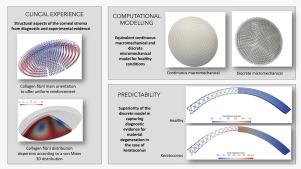角膜生物力学的连续模型与微观力学模型
IF 3.4
3区 材料科学
Q2 MATERIALS SCIENCE, MULTIDISCIPLINARY
引用次数: 0
摘要
人类角膜有两种可供选择的数值模型,用于模拟生理眼压(IOP)作用下的机械响应。第一个模型是连续模型或宏观力学模型,将基质组织视为散装材料,强化胶原纤维的空间分布具有随机性。第二个模型是离散模型或微力学模型,考虑的是唯一的胶原交联硬化微结构。这两种模型的几何形状是根据角膜地形图图像重建的。模拟考虑了健康角膜和角膜炎角膜的行为。对于角膜炎,部分角膜的材料属性降低到健康组织所用值的 1/8。研究发现,如果离散模型的材料参数选择得当,在健康角膜的情况下,两个模型的机械响应完全相似。在角膜病的情况下,两种模型都能准确捕捉到圆锥体的前部形状;此外,离散模型还能描述典型的病变组织变薄。尽管加入了随机材料特性,但从健康状态开始,角膜连续模型无法预测角膜变薄的情况,而加入底层胶原微结构则可以正确描述病理机械行为。本文章由计算机程序翻译,如有差异,请以英文原文为准。

Continuum versus micromechanical modeling of corneal biomechanics
Two alternative numerical models of the human cornea are used to simulate the mechanical response under the action of a physiological intraocular pressure (IOP). The first model is continuum or macromechanical, considering the stromal tissue as a bulk material with stochastic distribution of the spatial variability of reinforcing collagen fibers. The second model is discrete or micromechanical, considering the sole collagen-crosslink stiffening micro-structure. The geometry of the two models is reconstructed from corneal topographer images. Simulations consider the behavior of a healthy cornea and of a keratoconus cornea. For the keratoconus the material properties of a portion of the cornea are reduced to 1/8 of the values used for the healthy tissue. It is found that, for suitable choice of the material parameters for the discrete model, in the healthy case the mechanical responses of the two models are fully comparable. In the keratoconus case, both models capture with comparable accuracy the anterior shape of the conus; in addition, the discrete model is able to describe the tissue thinning typical of the pathology. Despite the inclusion of stochastic material properties, starting from a healthy condition, continuum models of the cornea are not able to predict the thinning of a keratoconus cornea, while the inclusion of the underlying collagen microstructure allows for a proper description of pathologic mechanical behaviors.
求助全文
通过发布文献求助,成功后即可免费获取论文全文。
去求助
来源期刊

Mechanics of Materials
工程技术-材料科学:综合
CiteScore
7.60
自引率
5.10%
发文量
243
审稿时长
46 days
期刊介绍:
Mechanics of Materials is a forum for original scientific research on the flow, fracture, and general constitutive behavior of geophysical, geotechnical and technological materials, with balanced coverage of advanced technological and natural materials, with balanced coverage of theoretical, experimental, and field investigations. Of special concern are macroscopic predictions based on microscopic models, identification of microscopic structures from limited overall macroscopic data, experimental and field results that lead to fundamental understanding of the behavior of materials, and coordinated experimental and analytical investigations that culminate in theories with predictive quality.
 求助内容:
求助内容: 应助结果提醒方式:
应助结果提醒方式:


